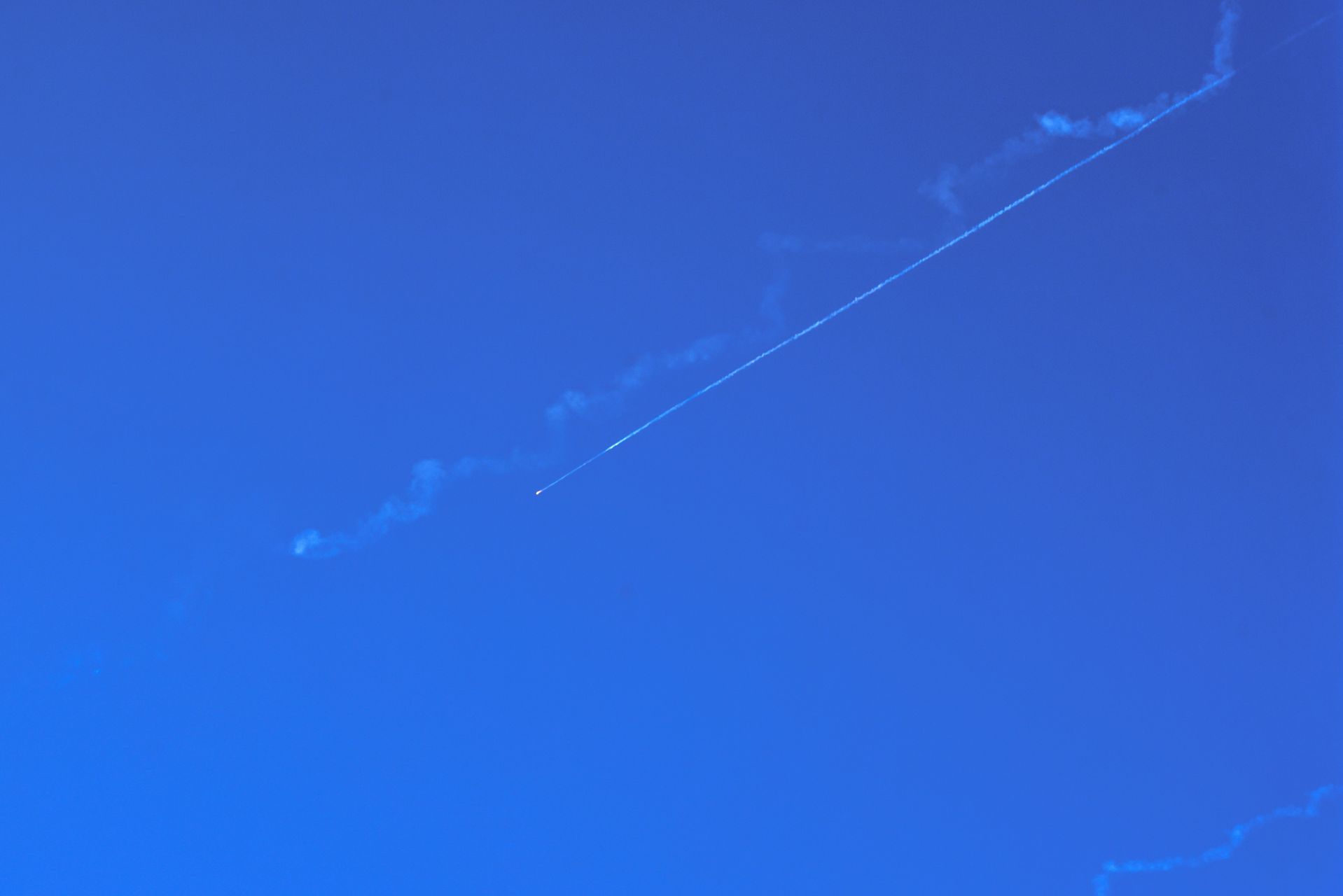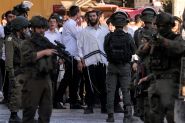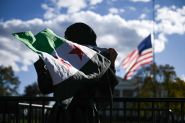- Home
- Middle East
- Day 8 of the Israel-Iran Conflict: Key Developments and Current Status

©(Photo by Zain JAAFAR / AFP)
Early on Friday, a missile launched by Iran struck near a technology hub in the southern Israeli city of Beersheba, igniting fires close to a building housing Microsoft’s offices.
Emergency responders confirmed that five people suffered minor injuries and shared images on X showing vehicles ablaze at the scene. Israeli news outlets reported that the missile missed its primary target, landing instead on an adjacent street and triggering the fire.
Iran’s Islamic Revolutionary Guard Corps (IRGC) claimed responsibility, stating that Microsoft was specifically targeted because of its collaboration with Israel’s military and intelligence services. The IRGC added that the area also includes residences of individuals linked to cyber and surveillance operations.
Israeli officials told local media that a missile interceptor was launched but failed to prevent the strike.
The Israeli army carried out numerous airstrikes across Iranian territory overnight. The military announced that more than 60 fighter jets participated in precision attacks on missile production sites, a nuclear research facility and other strategic locations. Reports indicate that an Iranian commander operating at a missile launch site was killed during these operations.
Israel's military said on Friday it struck dozens of targets in Tehran overnight, including what it called a center for the “research and development of Iran's nuclear weapons project.”
In a statement, the army said it had “completed a series of strikes in the heart of Tehran: dozens of targets were struck, including military missile production sites and the SPND (Organisation of Defensive Innovation and Research) headquarters for research and development of Iran's nuclear weapons project.”
According to the Israeli military, the SPND headquarters “is used for research and development of advanced technologies and weapons supporting the Iranian regime's military capabilities.”
“Among the targets were sites producing missile components and facilities manufacturing raw materials used in casting missile engines,” it added.
The military also said it intercepted overnight four UAVs launched from Iran.
In a separate statement, the army said on Friday it had hit “three ready-to-launch missile launchers aimed at Israeli territory.”
Iran’s Atomic Energy Organization confirmed in correspondence with the UN nuclear agency that the Arak heavy-water reactor sustained damage during the Israeli strikes on Wednesday night. Mohammad Eslami, the agency’s head, called on the international community to intervene and stop what he described as Israel’s violation of international norms.
Rising Casualties and Regional Tensions
The human cost of the conflict continues to mount. A Washington-based group, Human Rights Activists, reported that at least 657 individuals have died in Iran since Israeli attacks began on June 12. This figure includes 263 civilians and 164 members of security forces. Iran’s latest official figures released earlier this week put the death toll at 224.
On the Israeli side, authorities have reported a minimum of 25 fatalities resulting from Iranian missile strikes, with over 240 people injured.
Hezbollah’s Position Amid US Warnings
Secretary-General of Hezbollah Sheikh Naim Qassem declared his group will act in the conflict “as it sees fit,” rejecting any claim of neutrality. In a statement issued on Thursday evening, he described the conflict as “brutal Israeli-American aggression.”
His remarks follow direct warnings from the United States. Tom Barrack, the US special envoy for Syria, cautioned Hezbollah against engaging, stating, “On behalf of President Trump, who has made his position very clear, that would be a very, very, very bad decision.”
Qassem’s statement raised the ire of Israeli Defense Minister Israel Katz who responded on Friday saying that “Qassem has not learned a lesson from his predecessors and threatens to act against Israel according to Khamenei’s orders.”
Diplomatic Initiatives and International Responses
European foreign ministers are convening in Geneva today to hold direct discussions with Iranian Foreign Minister Abbas Araghchi in an effort to de-escalate tensions between Tehran and Jerusalem.
If the meetings proceed, they will represent the first face-to-face diplomatic engagement since Israel launched strikes in Iran last week and signify Europe’s increasing role in the crisis.
These talks come amid a two-week pause announced by US President Donald Trump on possible military action, aimed at allowing diplomatic channels to remain open.
UK Foreign Secretary David Lammy, after meeting US Secretary of State Marco Rubio in Washington, expressed cautious optimism, “A window now exists within the next two weeks to achieve a diplomatic solution.”
Reports from The Wall Street Journal indicate that President Trump has authorized contingency plans for military strikes but has delayed execution in hopes that negotiations will bear fruit. White House Press Secretary Karoline Leavitt said on Thursday that the president’s final decision on US involvement would be made “within the next two weeks.”
Meanwhile, the United Nations Security Council is scheduled to meet on Friday following Iran’s request, supported by Russia, China and Pakistan. Tehran has accused the International Atomic Energy Agency (IAEA) of bias towards Israel in its assessments of Iran’s nuclear activities.
Russia’s Warning on Regime Change
The Kremlin issued a strong message against any attempts to target Iran’s leadership. In an interview with Sky News, Russian spokesperson Dmitry Peskov said any assassination attempt on Supreme Leader Ayatollah Ali Khamenei would be condemned and could lead to increased radicalization.
“Regime change in Iran is unimaginable,” Peskov said. “It should be unacceptable, even discussing it should be unacceptable for everyone.”
His comments came after Israeli Defense Minister Israel Katz stated that Khamenei “can no longer be allowed to exist” following the missile strike on Soroka hospital.
Information Blackout and Civilian Impact in Iran
In response to the escalating conflict, Iranian authorities have implemented a widespread internet shutdown. Digital rights group NetBlocks described this blackout as the most extensive in Iran’s history, exceeding even the restrictions imposed during the 2019 protests.
Displaced Iranian civilians have described harrowing conditions under fire. Mohammad Hassan, a student at the University of Tehran who fled to Pakistan, told AFP, “Those days and nights were very horrifying... hearing sirens, the wailing, the danger of being hit by missiles.”
Global Evacuations Underway
Several countries are actively evacuating their nationals from Iran and Israel. China has repatriated over 1,600 citizens from Iran and hundreds from Israel. Australia is coordinating the evacuation of more than 2,700 people from both nations.
India has safely brought back students via Armenia, and Japan has deployed military aircraft to Djibouti in preparation for further evacuations. Pakistan reported thousands of its citizens have left Iran since hostilities began.
‘Day of Wrath’ in Iran
Iranian officials have called for nationwide demonstrations on Friday, describing them as marches of “wrath” and “victory” to be held following weekly Friday prayers. These rallies aim to express public outrage over Israeli airstrikes and to demonstrate solidarity with Iran’s military.
Read more





Comments